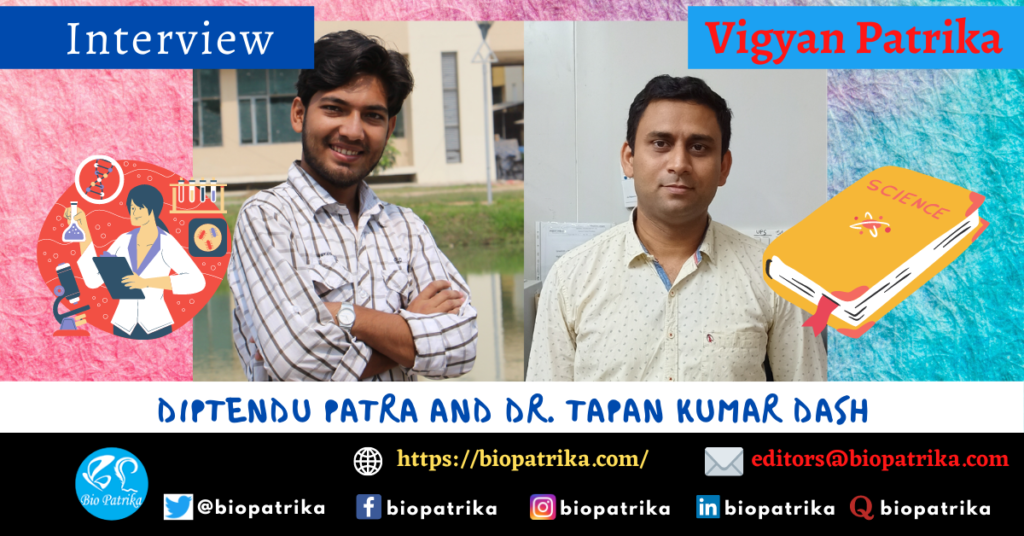Dr. Tapan Kumar Dash and Diptendu Patra’s joint interview with Bio Patrika hosting “Vigyan Patrika”, a series of author interviews. Tapan and Diptendu are joint-first authors on the recent research paper “Hetero-Trifunctional Malonate-Based Nanotheranostic System for Targeted Breast Cancer Therapy” published in ACS Appl Bio Mater. In this interview, they talk about this work done with Prof. Raja Shunmugam at Indian Institute of Science Education and Research Kolkata.
Diptendu Patra is currently a Senior Research Scholar under the supervision of Prof. Raja Shunmugam at Indian Institute of Science Education and Research Kolkata. His research work mainly focuses on the Magnetic Resonance Imaging (MRI) based nano-theranostic polymer systems for effective cancer therapy. He commenced his research work immediately after accomplishing the Master of Sciences (MS) in 2015 as an integrated PhD student at IISER K. He received his bachelor degree in chemistry honours from The University of Burdwan in 2013. The beauty of science keeps him motivated day by day to perform new research works. Herein, Diptendu briefly discussed the work on ‘Hetero-Trifunctional Malonate-Based Nanotheranostic System for Targeted Breast Cancer Therapy (ACS Appl Bio Mater).
Dr. Tapan Kumar Dash is an interdisciplinary scientist with specialization in pharmaceutical dosage form Design and Drug delivery. He had obtained his doctorate degree from National Institute Science Education and Research, Jatni, where his major focus was to develop nano-formulations containing multiple drugs for overcoming chemotherapy resistance in cancer. Later he worked as a National Postdoctoral Fellow at Indian Institute of Science Education and Research, Kolkata, in order to design, synthesize and develop multifunctional linkers for targeted cancer therapy and diagnosis. Currently, Dr Tapan is working as a Research and Development manager at Fibroheal Woundcare Private Limited, Bengaluru to explore biomaterial implications of silk protein for tissue regeneration and sustained drug delivery.
How would you explain your paper’s key results to the non-scientific community?
The work is based upon the treatment of CANCER, which is an uncontrolled growth of abnormal cells having the potential to invade and spread to other parts of the body. It is well-known that the imaging techniques help get the feedback of current-stages of the patient whereas the targeted chemotherapy helps reduce the side effects. Therefore, in this work, we have optimized our system to get a more stable micelle-based nanotheranostic system that is very efficient for folate-receptor targeting in the tumor site, magnetic resonance imaging capabilities, and an environmentally sensitive anticancer drug release. The study showed that the micellar aggregate possessed MRI tracking tumor-targeting capability that released the drug in a cancerous environment, helped reducing the side effects with incessant monitoring of the patient, and increase the survival rate.
What are the possible consequences of these findings for your research area?
These research findings showed integrated strategies of imaging and therapy, which provide the diagnosis and treatment simultaneously. Therefore, further enhancement of the efficacy of such a system might be the possible consequences of these findings for my research area.
What was the exciting moment (eureka moment) during your research?
When science showers its beauty, researchers get excited and the feeling is ‘EUREKA’. Similarly, the entire research work tenure is a package full of exciting or the ‘eureka’ moments. During this work, the process of achieving the most stable and smaller micellar aggregation was quite exciting to me. Once, the optimized nanotheranostic system showed the folate receptor targeting efficiency, making it the most exciting moment of this work.
What do you hope to do next?
I am very much interested in carrying forward our research work that can contribute to the scientific society and its people. The primary aim is to prepare a suitable polymer-based delivery system that can easily overcome the drawbacks of clinically applied drug delivery strategies and improve the survival rate.
Where do you seek scientific inspiration?
My family always insisted on exploring scientific exhibitions, where I was introduced to many interesting scientific experiments. However, my main scientific inspiration was after working with one of the distinguishable scientists in the field of polymer, Prof. Raja Shunmugam, who helped me develop numerous practical skills throughout my research tenure.
to maintain and improve our performance towards science, it is essential to nurture interests of the new generation of students by demonstrating scientific experiments, encouraging their participation in scientific programs, etc.
How do you intend to help Indian science improve?
According to me, when talking about science, the beauty of science is what mainly draws attention considering our ‘Indian Science’ has been performing remarkably enough to draw everyone’s attention across the globe. Therefore, to maintain and improve our performance towards science, it is essential to nurture interests of the new generation of students by demonstrating scientific experiments, encouraging their participation in scientific programs, etc. There should be practical experiments demonstration class with proper justification or explanation in a scientific way at the school levels that surely will motivate the students; the future of our country.
In the research field, industry-institution collaboration must substantially positively impact research progress and the proper utilization of the research outcome. The industrial applications of the research outcome will help society get the benefit of the research. In our country, industry-institution can quickly help improve social awareness and lead our community towards a bright future.
Reference
Tapan Kumar Dash, Diptendu Patra, Parvathy Venu, Biswajit Das, Rangeet Bhattacharyya, and Raja Shunmugam. Hetero-Trifunctional Malonate-Based Nanotheranostic System for Targeted Breast Cancer Therapy. ACS Applied Bio Materials. DOI: 10.1021/acsabm.1c00407
Lab website: https://www.iiserkol.ac.in/~sraja/rajashunmugam.weebly.com/index.html
Edited by: Nikita Nimbark

